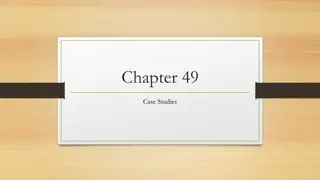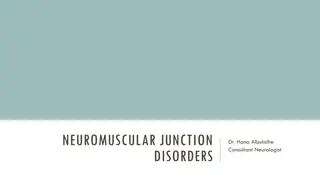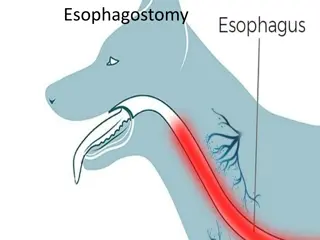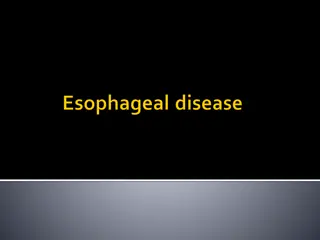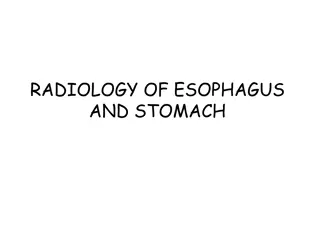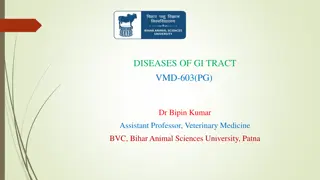Understanding Esophageal Diseases: Anatomy, Physiology, and Disorders
Explore the anatomy and physiology of the esophagus, learn about common esophageal disorders such as GERD, understand the symptoms, complications, and management of reflux disease, differentiate between oropharyngeal and esophageal dysphagia, and delve into the causes, symptoms, investigations, and treatments of dysphagia.
Download Presentation

Please find below an Image/Link to download the presentation.
The content on the website is provided AS IS for your information and personal use only. It may not be sold, licensed, or shared on other websites without obtaining consent from the author. Download presentation by click this link. If you encounter any issues during the download, it is possible that the publisher has removed the file from their server.
E N D
Presentation Transcript
Lecture 28 Editing file Editing file Esophageal Diseases Objectives: Describe the major components in the anatomy of the esophagus and physiology of swallowing . Explain the pathophysiology and etiology of common esophageal disorders. Name the common presenting symptoms and complications of reflux disease (GERD) . List the main points in the management of GERD . Differentiate between oropharyngeal and esophageal dysphagia . Explain the differences between anatomical and functional esophageal disorders . Explain the pathophysiology of common causes of dysphagia. List the common presenting symptoms, appropriate investigations and treatment options in different causes of dysphagia . Color index: Color index: Original text Females slides Males slides Doctor s notes Text bookImportant Golden notes Extra
Introduction 2 Anatomy of the esophagus Muscular tube stomach. it has an UES & LES that help empty food between swallows while preventing regurgitation of stomach contents The oesophagus is lined by hcihw , sugahposeo eht erehw noitcnuj ranmulocomauqs eht ot yllatsid sdnetxe hcamots eht snioj . striated muscles make up the proximal smooth muscles make up the distal . how long does it take a bolus to pass the entire esophagus? about 7 - 10 seconds. Esophageal sphincters 25 - 20 cm long, located between the pharynx and the muilehtipe suomauqs deifitarts . Upper esophageal sphincter Lower esophageal sphincter VS - A physiological sphincter comprised of smooth muscles. Normally located within the diaphragmatic hiatus with in the abdominal cavity and in the thoracic cavity. yllamixorp decalpsid eb naC ainreh sutaih yb )retal dessucsid( It maintains a high pressure zone between stomach and esophagus )xulfer ot reirrab( - Functions to prevent regurgitation ytivac laro otni xnyral dna Restricts airflow into the esophagus during inspiration. Composed of striated muscles suoicsnoc rednu era ,gnihtaerb nehw desu ,lortnoc gnitimov dna ,gnihcleb ,gnitae . - - - dna - Physiology of swallowing UES opens and bolus is introduced into the esophagus.esophagus distends causing a contraction proximal to distal. propagating sequence. Primary peristalsis: xnyrahp eht ni detaitini by a swallow eht . gnivom wols era sevaw eritne eht peews dna eht fo htgnel sugahpose . Secondary peristalsis: initiated by esophageal distention by food. these waves are important to remove all the food from the esophagus if it has not been totally cleared by primary peristalsis LES open at the end of swallowing to allow the food to pass to the stomach
GASTROESOPHAGEAL REFLUX DISEASE (GERD) 3 Introduction Symptoms or complications resulting from the gnul ro )xnyral gnidulcni( ytivac laro eht otni Transient lower esophageal sphincter relaxations (TLESRs sugahposeo eht otni kcab wolf ot dica cirtsag gniwolla ,DREG htiw stneitap ni yltneuqerf erom rucco . Prevalence in Saudi Arabia is 30% - 40% . What causes GERD? Hiatal hernia Hypotensive LES Increase Intra-abdominal pressure (eg: Pregnancy, obesity) Factors associated with GERD ,dnoyeb ro sugahpose otni stnetnoc cirtsag fo xulfer 1) are part of normal physiology, tub Fat, chocolate, coffee or alcohol ingestion, Large meals Cigarette smoking 2 1 Pregnancy or obesity 3 Treatment for achalasia Drugs antimuscarinic, calcium-channel blockers, nitrates Hiatus hernia, cimetsyS sisorelcs 6 4 5 SYMPTOMS OF GERD Heartburn is the major feature si taht niap tsehc gninrub a si sihT . aggravated by bending, stooping and lying down etomorp hcihw fo lla , erusopxe dica . Regurgitationoffood and acid into the mouth occurs, particularly on bending or lying flat. ,htuom eht ni noitavilas ssecxe ot dael nac sihT sa nwonk ylnommocwater-brash. Typical Chest pain dna gnihcleb ,gnitaolB ,aesuaN ,yteitas ylraE ,Globus sensation3 Atypical Cough, Asthma, Laryngitis, Sinusitis/recurrent otitis media, Dental erosions Extra Esophageal Classic features of GERD and cardiac ischaemic pain A cardiac cause should be excluded in patients with chest pain before starting GI evaluation2. Reflux Pain Cardiac Ischaemia Pain Rarely radiates to the arms Gripping or crushing, Radiates to neck or left arm Worse with spicy food, hot drinks or alcohol Worse with exercise Relieved by antacids Accompanied by dyspnoea 1 - In TLESR the LES sphincter relax 2 - All patient with chest pain must undergo cardiac evaluation first (ECG) before doing any GI evaluation. Even if they present with very suggestive signs and symptoms of GERD 3 - Very common, pt words I feel something is stuck in my throat, and isn t relieved by eating or drinking 3 - 6 time every hour for 10 sec to allow gases to go out of the stomach, otherwise bloating will occur (Considered as a protective mechanism) 3 - tI . s a sensation caused by the irritation of the esophagus.
GASTROESOPHAGEAL REFLUX DISEASE (GERD) 4 HOW TO DIAGNOSE GERD? The clinical diagnosis can usually be made without investigationand is often made using mainly: Typical symptom presentation . Antisecretory responsiveness. (PPI responsive) In some cases you will need to go further with : Ambulatory reflux monitoring (PH study) Endoscopy indications for endoscopy in suspected GERD: 1. Alarm symptoms, like? Dysphagia, Weight loss, Positive family or personal history of esophageal malignancy Hematemesis, Melena, Anemia. 2. Non-Cardiac chest pain 3. Screening high risk patients for Barrett s: ,thgiewrevo ,srekoms ,DREG cinorhc , ylimaF yrotsih 4. Patients that areIPP ot evisnopsernu Indications for ambulatory PH monitoring: 1. Suspected GERD with normal Endoscopy)DREG mrifnoc ot( 2. Persistent symptoms even with PPI rehto o/R oT( )sesuac 1 naht redlo ,selam etihw 50 MANAGEMENT OF GERD Weight loss, Head of bed elevation at night, Smoking Cessation Avoidance of meals 2 - 3 hours before bedtime for patients with nocturnal GERD . Culprits: fatty foods, caffeine, chocolate, ETOH, spicy foods, carbonated beverages, peppermints Lifestyle changes Proton pump inhibitors (PPIs snoitacidem desu ylnommoc tsom eht era ) , usually effective in resolving symptoms and healing esophagitis. domperidone nac ,tnenimorp era serutaef ytilitomsyd antacids and alginates can also provide symptomatic benefit. H gnilaeh tuohtiw smotpmys gnivloser ni lufpleh ,sgurd sitigahpose . nehw , be helpful. Medical tsinogatna rotpecer 2 - 2 Fundoplication era noitacilpodnuF rof : Persistence reflexeven with PPI s Barrett s esophagus snoitacidnI eht ,DREG dna ainreh lataih htob taert nac hcihw , Surgical 1 - Patients with functional esophagitis: the esophagus is hypersensitive and gets irritated from anything, not necessarily acid. We monitor the pH to know the nature of the reflux causing the irritation 2 - Patients undergoing Fundoplication must be evaluated first by endoscopy to make sure they have a reflux. If normal, do PH monitoring.
GASTROESOPHAGEAL REFLUX DISEASE (GERD) 5 Complications 01 Erosive Esophagitis: AKA Ulcerative esophagitis, if left untreated it will lead to Barrett s Esophagus. Treatment )sIPP( srotibihni pmup notorp : 02 Barrett s Esophagus : Metaplastic columnar epithelium (gastric and intestinal) replaces the stratified squamous epithelium in the distal esophagus, it s More common in Men. Risk Factors for Barrett s: Chronic (>5 years) GERD symptoms, Advancing age (>50 years). Male gender, Caucasian race, Family history Tobacco usage ytisebo lartneC , . Alcohol doesn t increase risk of Barrett s The risk of cancer seems to relate to the severity and duration of reflux naht rehtar tterraB fo ecneserp eht s oesophagus per se. Metaplasia1 tterraB( High Grade dysplasia (HGD) s) 02 03 04 01 05 Adenocarcinoma 2 GERD Low Grade dysplasia (LGD) 03 Peptic Stricture: They usually occur in patients over the age of 60 and present with intermittent dysphagia for solids revo yllaudarg snesrow hcihw , doirep gnol a . Mild cases may respond to PPIs alone. More severe cases need endoscopic dilation dnalong-term PPI therapy. Surgery is required if medical treatment fails. 1 - PPi s have the capability to stop the progression of Barretts s metaplasia to dysplasia, But has no benefit once patients develop dysplasia (even low grade). 2 - A patient has cancer in the lower esophagus, what is the most likely type ? Adenocarcinoma What is the most likely risk factor ? Barrett s esophagus secondary to GERD
6 DYSPHAGIA Introduction Subjective sensation of difficulty or abnormality of swallowing. Oropharyngeal vs Esophageal dysphagia1. Esophageal Dysphagia 2 Oropharyngeal Dysphagia Recurrent Pneumonia (Aspiration) Weight loss Coughing or choking with swallowing. Usually no problem with initiation of swallowing. Difficulty initiating swallowing. Sensation of food getting Stuck in the chest. Change in Voice or Speech Can have Pain in the chest sulob doof morf . Nasal regurgitation. Oral or Pharyngeal regurgitation. Systemic Neurologic ro )ekortS sa hcuS( )sitisoymotamred sa Myopathic hcuS( Functionalor Anatomicalabnormalities in the esophagus . semordnyS Functional causes: Achalasia. Secondary dysphagia. Esophageal spasm. Eosinophilic esophagitis. Anatomical causes: Esophageal strictures Esophageal ring. Esophageal web. Malignancy. HISTORY TAKING IN DYSPHAGIA 01 03 05 07 Duration (weeks/months vs years) Stable vs progressive Associated symptoms (weight loss, anemia/blood in stool Onset 06 04 02 Intermittent vs persistent Regurgitation Solids vs Solids + liquids ) Solid vs both solid and liquid Oropharyngeal or esophageal CARDINAL SIGNS FOR DYSPHAGIA Persistent vs intermittent Important associated symptoms 1 - it s very imp to differentiate between them. 2 - In esophageal dysphagia, function refers to the movement While anatomy refers to obstruction caused by cancer/strictures
Oropharyngeal Dysphagia 7 Zenker s diverticulum AKA cricopharyngeal diverticulum asocum eht fo gnihcuoptuo ,ekil caS , fo aera eht ni asocumbus dnamuscular weakness xnyrahpopyh eht ni elcsum suegnyrahpocirc dna rotcirtsnoc roirefni eht neewtebabove the UES. An areaof weakness known as nailliK diverticulum to form. Introduction s dehiscence allows a pulsion Hypertensive / noncompliance of the Upper esophageal sphincter Cause Oropharyngeal dysphagia symptoms. Food undigested on the pillow at night or after meals. Halitosis1. Weight Loss & gib semoceb mulucitrevid eht( segats etal ni sneppah stcurtsbothe esophagus) Occasionally, patients present with recurrent pneumonia gniwollof otni doof fo noitaripsathe trachea. They may also complain that a kcen eht ni draeh si hcuop eht ni tcelloc doof dna diuqil sa wollaws a gniwollof . Symptoms2 dnuos gnilgrug Diagnosis: Video swallow testing Modified barium swallow. Endoscopy may be hazardous dna retne yam tnemurtsni eht ecnis , hcuop eht etarofrep . Treatment: Surgical ,ro desicxe si hcuop eht erehw kcen eht hguorht hcaorppa lanretxe na aiv rehtie , more commonly, via endoscopy with stapling of the party wall 1 - Halitosis is considered as a characteristic feature of Zenker s diverticulum that every physician must keep an eye on secondary to retention of undigested food. 2 - In late stages of zenker's diverticulum, Patients may present with symptoms of both oropharyngeal and esophageal dysphagia as it begins to obstructs the esophagus.
Esophageal Dysphagia 8 1 - ESOPHAGEAL STRICTURE Causes: Diagnosis: Treatment: Benign peptic stricture caused by GERD Malignant stricture Iatrogenic? eg: Suicidal ingestion of acids Done by endoscopy Depends on the cause: 3 months history of dysphagia? most likely secondary to GERD treat it with PPI s. Didn't work? then its either secondary to fibrosis > Dilation, or cancer > resection 2 - ESOPHAGEAL RINGS AND WEBS Esophageal ring Esophageal web Common in the lower esophagus (above LES) Usually in upper)lacivrec( sugahpose Connective tissue + muscularis mucosa Thin membrane Caused by ? GERD Unknown cause? Genetic 2) 1 Schatzki s ring Plummer vinson syndrome dairt( PVS has increased risk for squamous cell cancer in the esophagus, hypopharynx and oral mucosa. No cancer risk Diagnosis: barium, endoscopy Treatment: endoscopic dilationif needed (persistent symptoms) PPI daily for GERD Iron replacementSVP fi ypareht 1 - Supplementing PVS patients with iron will make esophageal web disappear,however they need continuous surveillance as they have an increased risk of esophageal squamous cell carcinoma 2 - the triad of Plummer vinson syndrome are: Dysphagia, Iron deficiency anemia, and esophageal webselamef gnuoy ni nommoc yreV .
ESOPHAGEAL DYSPHAGIA 9 ESOPHAGEAL MOTILITY DISORDERS CAUSING DYSPHAGIA Aperistalsis in esophagus (connective tissue disease) (Scleroderma) Esophageal spasms Achalasia 3 - Achalasia Achalasia Pathophysiology: Failure of lower esophageal sphincter to relax (lacking ganglion cells in the myenteric plexus in the distal esophagus) . Males =Females Characterised by: A hypertonic lower esophageal sphincter, which fails to relax in response to swallowing waves. Failure of propagated esophageal contraction, leading to progressive dilatation of the gullet. Etiology : Immune mediated. Genetic predisposition . Primary Achalasia1 Chagas disease yb noitcefnI citisaraP ,Trypanosoma cruzi nital ni nommoc( ciretneym ciretne esuffid fo serutaef htiw aisalahca ni tluseR ,)aciremA ,noitcurtsedincluding megacolon, heart disease (cardiomyopathy), and neurologic disorders. Diagnosisygolores :testing. Treatment ekil amosonapyrt itnA :Benznidazole deganam smotpmys IG( yllacitamotpmys Secondary Achalasia2 3) Achalasia symptoms and similar diagnostic findings. Due toMalignancy eht gnitartlifni esoht ro aidrac cirtsag eht ni sromut( laegahposeortsag fo amonicraconeda ekil suxelp ciretneymjunction, pancreatic, breast, lung, or hepatocellular cancers) When to suspect (rapid onset over weeks-months4 for cancer) Need to get CT scan or endoscopic US for further workup. Pseudoachalasia5 , elderly and risk factors 1 - Primary achalasia is the comments, Patients present with history of esophageal dysphagia that persist for years 2 - The main feature of secondary achalasia is that it is multi-system si tI .ylno sugahpose eht ot detcirtser ton dna )yramirp ekilnu( Important to look for and ask about travel historyaisalahca yradnoces ni 3 - Symptoms are reversible following anti trypanosoma treatments except for the esophagus(irreversible damage), thats why its managed symptomatically 4 - Keep in mind that even 8Months in Pseudo-achalasia is considered as rapid onset in comparison to primary achalasia( which usually takes 5 - in pseudo achalasia, CT scan or endoscopic US is a MUST to roll-out carcinoma specially in high risk group (but it has to be done after the usually workup approach: (barium, endoscopy, and manometry to diagnose and confirm achalasia first) 2 - 3 ( years history) 2 - 3 years)
ESOPHAGEAL DYSPHAGIA 10 3 - Achalasia (Cont.) Symptoms of Achalasia: Regurgitation of undigested food Dysphagia to solids and liquids Heartburn1 Chest pain6 Weight loss Diagnosis of Achalasia: 01 03 Esophageal Manometry: Shows aperistalsis of the esophagus and failure of relaxation of the LOS. Confirmatory test Barium swallow(First Step): Dilated esophagus Tight LES BIRD BEAK APPEARANCE 02 Endoscopy Normal with some resistance at the LES Dilated esophagus. Retained saliva, liquid, and food in the esophagus without mechanical obstruction from stricture or mass Management of achalasia: Medical therapy3: Calcium channel blocker Nitrate Antimuscarinic agents. Endoscopic therapy: Pneumatic dilatation Botox injection at LES( .effective/ short term Peroral endoscopic myotomy (POEM) 4 )snoitacilpmoc erom /mret regnol /evitceffe( 3 - 6 months ) Surgical (Heller s myotomy): performed laparoscopically or as opened surgery, accompanied by a partial fundoplication anti-reflux surgery. Higher risk for Esophageal squamous cell cancer . 1 - Heartburn in achalasia is due to acids in foods which accumulate in the esophagus 3 - Medical therapy for achalasia almost never work, however we can describe it for elderly patients with comorbidities that prevent them from doing any endoscopic or surgical procedure 4 - pneumatic dilation is associated with risk of perforation 6 - some patients experience severe chest pain due to esophageal spasm; it might be misdiagnosed as cardiac pain.
11 ESOPHAGEAL DYSPHAGIA 4 - Diffuse esophageal spasm (DES) Diffuse esophageal spasm (DES) (corkscrew esophagus( A severe form of esophageal dysmotility that presents in late middle age with episodic retrosternal chest pain (that can mimic angina) and aigahpsyd tneisnart Could occuras a response to gastroesophageal reflux. Can be precipitated by drinking cold liquids. On barium swallow, the appearance may be that of a corkscrew esophagus. Nutcracker deziretcarahc si ,msaps laegahpose esuffid fo tnairav a ,by very high-amplitude peristalsis nihtiw the esophagus. Treatment is based on PPI when gastroesophageal reflux is present, antispasmodics, nitrates, calcium channel blocker (nifedipine) and GABA agonists (baclofen) are also used. Occasionally, balloon dilatation or longitudinal esophageal myotomy is necessary. DES and nutcracker can be distinguished only by manometry. . 5 - Eosinophilic Esophagitis Eosinophilic Esophagitis1 Chronic inflammation due to sugahpose fo noitartlifni cilihponisoe No malignancyPotential. Commonly present with food impaction. Main symptom is dysphagia. History of allergies is seen in >50%of these patients. ni gnitluser esaesid detaidem enummi - Overview Endoscopy: Can be normal. Strictures. linear furrows. Trachealization of the esophagus. BIOPSY shows 15 or more eosinophils lamixorp morf( ypocsorcim no fph/ sugahpose latsid dna Diagnosis 2) PPI first for 8weeks then repeat Endoscopy if Eosinophils is still 15or more: Corticosteroids dewollaws( fluticasone/ budesonide/betamethasone(for If symptoms persists repeat endoscopy if there s a ring try dilation. Leukotriene inhibitor (montelukast) for refractory symptoms. Elimination diets for children. 3 12 weeks. 8 - Treatment 1 - Patients with Eosinophilic esophagitis may present with history of allergies eg: Asthma, allergic rhinitis, food allergies 2 - Biopsy MUST be taken from both ends of the esophagus as refluxes may also cause eosinophilia 3 - Corticosteroids are initiated if PPI didn t work, it has to be swallowed (the patient has to use corticosteroid inhaler(not tablets!) but instead of inhaling the substances he swallows them)
ODYNOPHAGIA+/-DYSPHAGIA 12 Acute Esophagitis 2 1 Pill-induced1 Antibiotics: )Tetracycline/Doxycycline( A patient taking tetracycline for his acne present complaining of acute odynophagia for one week, what is the most likely the diagnosis and the cause? Bisphosphonate )alendronate( A 50 years old post menopausal woman present with odynophagia following bisphosphonate therapy for her osteoporosis, what is mostly likely the diagnosis and the cause? Potassium A HF patient on lasix and diuretics with hypokalemia using potassium supplements Treatment: Stop the medication and give them PPI 2 1 Infections Immunocompromised patients Patients on corticosteroid therapy are at risk of Infection induced acute esophagitis Viral )VSH ,VMC( Treatment: antiviral Candida Treatment: anti fungal 1 - The comments site for pill induced acute esophagitis is at the aortic constriction of the esophagus as it is considered as the tightest area of the esophagus where pills can get stuck (produce kissing ulcer appearance), for that when you prescribe these medications, advise the pt to drink a lot of water and stay in upright position at least for 30 min after taking the pill.
Summary GERD Typical Atypical extra-esophageal sitignyral ,snoisore latned ,amhtsa ,hguoc ,aidem sitito tnerrucer / sitisunis : . ,)erutaef rojam eht( nrubtraeh : noitatigruger ,noitasnes subolg ,gnihcleb dna gnitaolb ,niap tsehc Sx , aesuan : early satiety. clinical ssenevisnopser yrotercesitna ,noitatneserp motpmys lacipyt : . endoscopy stneitap ksir hgih gnineercs ,niap tsehc caidrac non ,smotpmys mrala fo esac unresponsive to PPI. 24h pH monitoring and motility IPP htiw neve smotpmys tnetsisreP ,ypocsodne lamron htiw DREG detcepsus : . ni : for Barrett s, Pts Dx MGT PPI, antacids and alginates, domperidone, H2 receptor antagonist. peptic strictures erosive esophagitis. Barrett s esophagus amonicraconeda . . yllaudarg snesrow hcihw sdilos rof aigahpsyd tnettimretni , 60 > : Cx rof ksiR ,ytisebo lartnec ,occabot ,yrotsih xF ,smotpmys DREG cinorhc , > nem etihw : 50 Zenker s diverticulum oropharyngeal dysphagia symptoms, undigested food on the pillow at night or after meals, Halitosis, Weight loss in late stage Sx Dx modified barium swallow, video swallowing testing surgical Either via external approach (through the neck) or endoscopy (more commonly) with stapling of the party wall. Tx eosinophilic esophagitis dysphagia or food bolus obstruction chest pain and heartburn yb desuac the eosinophil induced esophageal inflammation History of allergy seen in >50% of patients. Sx Dx endoscopysugahpose eht fo noitazilaehcart / sworruf raenil / serutcirts / lamron eb nac : PPI rof tsrif desu : 8 corticosteroidsdewollaws : fluticasone / budesonide / betamethasone montelukastsmotpmys yrotcarfer rof : weeks then repeat endoscopy. Tx Esophageal webs and rings Esophageal ring Esophageal web Common in the lower esophagus (above LES) Usually in upper esophagus (cervical) Connective tissue + muscularis mucosa Thin membrane Caused by ? GERD Unknown cause ?genetic Schatzki s ring Plummer vinson syndrome (triad) No cancer risk PVS has increased risk for squamous cell cancer in the esophagus, hypopharynx and oral mucosa. Diagnosis:ypocsodne ,muirab Treatment:)smotpmys tnetsisrep( dedeen fi noitalid cipocsodne PPI daily for GERD Iron replacement therapy if PVS
Summary Esophageal strictures causes Benign peptic strictures, malignant strictures, iatrogenic. Dx Endoscopy. Depends on the cause: 3 months history of dysphagia? most likely secondary to GERD treat it with PPI s. Didn't work? then its either secondary to fibrosis > Dilation, or cancer > resection Tx Achalasia Primary achalasia detagaporp fo eruliaf dna ,sevaw gniwollaws ot esnopser ni xaler ot sliaf hcihw SEL cinotrepyH : tellug eht fo noitalid evissergorp ot gnidael noitcartnoc laegahpose . Immune mediated and genetic predisposition. dysphagia (develops slowly,initially intermittent, solids and liquids), chest pain( due to esophageal spasm), regurgitation and pulmonary aspiration, heartburn and weight loss. Sx barium esophagography a otni gniworran sugahpose eht fo noitatalid swohs esophageal manometry ,noitcartnoc edutilpma wol ,noitaxaler laitrap/on + erusserp gnitser SEL desaercni swohs no propagation. endoscopy eht ni doof dna diuqil ,avilas deniater dna sugahpose setalid ,SEL eht ta ecnatsiser emos htiw lamron sugahpose . beak-like pattern at the lower end. Dx drugs: stnega ciniracsumitna / rekcolb lennahc muiclac / nirecylgortin . endoscopic: lufecrofpneumatic dilatation / botulinum toxin injection / peroral endoscopic myotomy. surgical myotomy (Heller s operation). MGT Diffuse esophageal spasm (corkscrew esophagus) Sx Episodic retrosternal chest pain and (can mimic angina), dysphagia, precipitated by drinking cold liquids. Dx Barium swallow sugahpose wercskroc a fo taht ebyam ecnaraeppa : . PPI when GER is present. Tx Antispasmodics, Nifedipine (CCB) and nitrates. -achalasia -secondary dysphagia -esophageal spasm -eosinophilic esophagitis functional esophageal anatomical dysphagia -esophageal stricture -esophageal ring -esophageal web -malignancy Zenker s diverticulum oropharyngeal neurologic myopathic
Lecture Quiz (Dr s slides) Q medical conditions and is currently not taking any medications. You suspect that he may have GERD. Which of the following describesthe roleof upperendoscopy inthe evaluation of this patient ? A- He should undergo an Esophagogastroduodenoscopy with biopsy to ensure a more serious condition is not missed B- He should undergo an Esophagogastroduodenoscopy only if he has no improvement in his symptoms after an empiric trial of twice daily PPI therapy. C- He should undergo ambulatory PH monitoring while on PPI therapy to ensure the medication is working D-He should undergo both an Esophagogastroduodenoscopy and ambulatory PH monitoring prior to the initiation of any therapy . 42 A 1 : y/o male presents for evaluation of heartburn. He denies any dysphagia or weight loss. He has no other Q 4 often wakes up with a sour taste in his mouth. He reports no dysphagia or unintentional weight loss. He takes no medication. On physical examination, vital signs are normal; BMI is elbakramernu . tahW dluow eb eht txen pets ni sih tnemeganam ? A- PH testing B- Barium esophagography C- Empiric trial of proton pump inhibitor D-Esophagogastroduodenoscopy gnitaidar gnirrucco dna hcamots ,tsehc yllausu sih sih ni gnitrats otni to 5 times weekly. He says that he usually eats dinner late and then goes to sleep. He noitasnes gninrub a fo yrotsih htnom 2 - a rof detaulave si nam dlo - raey - 45 A 2 : gnidulcni ,noitanimaxe ,noitanimaxe lanimodba eht fo redniamer ehT . 34 si Q elihw feiler fo lacisyhp 140/90 pets ? A- Barium esophagography B- Electrocardiography C- Empiric trial of a proton pump inhibitor D-Esophagogastroduodenoscopy gnidecerp semitemos laminim nO si txen yltnettimretni seciton siht niap eniditinar htiw setteragic yliad doolb erusserp tahW si ruoy eht revo gnirrucco ehs osla neeb gnikat a kcap ,noitanimaxe elbakramernu slaem syas sah sekoms mm Hg and other vital signs are normal; BMI is gnidulcni lanimodba ,noitanimaxe retfa dna . trofmocsid reh ,tsehc ro xulfer . ehS tsehc ssenivaeh no ,aigahpsyd aimedipilrepyh detaulave noitasnes fo on ,aesuan nitatsavrota rof rof namow sebircsed a ehS stroper sekat eht si raey ehS pu . ehS redniamer dlo - 56 . gniklaw smotpmys ehT - A - 3 : taht htnom ehS . sriats . fo flah osla fo reh . 34 . si ,noitanimaxe Q necessity to induce vomiting several times each month to relieve his symptoms. He alsohas experienced chestpain and heartburn symptoms. He has lost approximately 6 kg (13 lb) of weight over the preceding 3 months and a total of 9 kg (20 lb) since his symptoms began. He has a long history of cigarette and alcohol use. His medical history and review of systems is otherwise negative. He has no travel history outside the northeastern United States. He takes no medication. On physical examination, vital signs are normal; BMI is ypocsonedoudortsagogahposE sgnidnif laever deniater ,avilas ,diuqil dna doof yrtemonaM setartsnomed etelpmocni rewol laegahpose noitaxaler dna sislatsirepa . tahW si eht tsom ylekil sisongaid ? A- Achalasia B- Pseudoachalasia C- EOE D-Chagas disease 8 fo aigahpsyd evissergorp rof detaulave si nam dlo - raey - 75 A 4 : - months' duration for both solids and liquids and the eht fo redniamer ehT . derit dna si niht sraeppa eH . 23 . elbakramernu lacinahcem noitanimaxe sugahpose tuohtiw lacisyhp eht . noitcurtsbo ni Q after eating solid food, occasional coughing and choking after swallowing, and chronic halitosis. He reports no weight loss or chest pain. He drinks two beers weekly and does not smoke. On physical examination, vital signs are normal; BMI is lanimodba ,noitanimaxe si elbakramernu . tahW si ruoy txen pets ? A- Barium esophagram B- Esophagogastroduodenoscopy C- Manometry D-PH study 3 fo aigahpsyd rof detaulave si nam dlo - raey - 52 A 5 : months' duration. He reports regurgitating undigested food soon gnidulcni ,noitanimaxe eht fo redniamer ehT . 25 Q sometimes forces himself to vomit when he feels food "stuck" in the esophagus, but he has never gone to the emergency department. He takes a multivitamin and is generally healthy.On physical examination, vital signs and other findings, including those of an abdominal examination, are unremarkable. Esophagogastroduodenoscopy findings are shown. Biopsies of the esophagus show more than 18 eosinophils/hpf. Which of the following is the most likely diagnosis? A- Achalasia B-Eosinophilic esophagitis C- Gastroesophageal disease D-Pill induced esophagitis 25 A 6 : year old man is evaluated for a sensation of solid food "sticking" several times per week. He reports that he Answers: Q B: Q | A: 6 Q | B: 5 Q | B: 4 Q | C: 3 Q | B: 2 1
THANKS!! This lecture was done by: - Faisal G Al-Zahrani - Nawaf Albhijan Quiz and summary maker: - Faisal G Al-Zahrani Note taker: - Khaled Al-harbi Females co-leaders: Raghad AlKhashan Amirah Aldakhilallah Males co-leaders: Mashal AbaAlkhail Nawaf Albhijan Send us your feedback: We are all ears!


